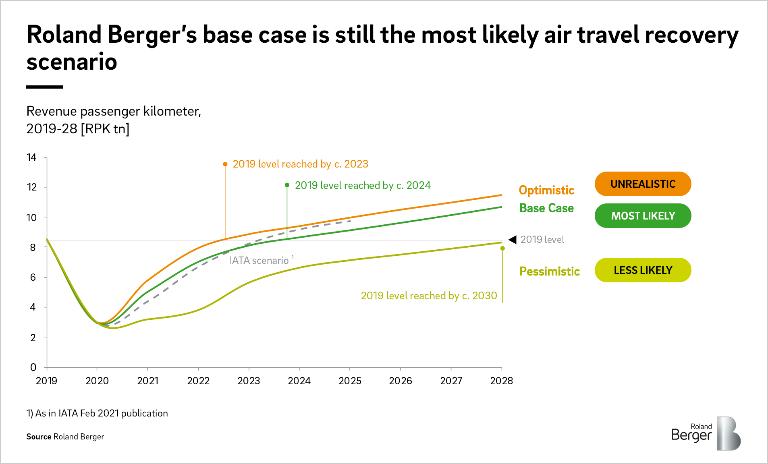Learn more about this year's aerospace and defence survey and get insights into pre-and post-Covid industry priorities.


A flight path to post-Covid success
Why digitalizing their operating model can help aerospace firms soar again
Torsten Welte
Global Head Industry Business Unit Aerospace & Defense, SAP
It’s been a tough year for aerospace players, and the short-term future remains highly uncertain. But by reassessing their operating model and introducing digital solutions to improve competitiveness and operational excellence, aerospace players can win out whatever challenges arise.

It’s safe to say that the past year was not only the most difficult, but also the busiest, 12 months for the aerospace industry in decades. The Covid-19 pandemic forced companies to battle on many fronts simultaneously, be it on safety, liquidity, supply chain or cost cutting. To make matters worse, this was done largely in the dark due to the industry having lost its ability to manage crises after a long period of growth and ramp-up.
Considering the enormity of the impact on air traffic and airlines, the industry has done a tremendous job ramping down production in an orderly fashion and keeping the supply chain intact. However, much of this activity was aimed at placing the industry in hibernation: the reflex was to return to the pre-ramp up production system of 2015 and wait to ramp-up again from there.
To date, companies have been fully occupied managing operational priorities. They have not had time to envision a future that could be significantly different to the past. A lack of clarity on the post-Covid situation has also limited planning. As a result, industry players have not yet developed a strategy, operating model or culture that will meet the challenges of the post-Covid world.
We believe the time is now right to do exactly that. As such, this article looks at the emerging post-Covid trends in the industry, and outlines why enhancing competitiveness and operational excellence through digitalization – doing more with less – will be the key to success.
The challenges of the post-Covid world
It is still difficult to predict how the market will perform in the short term as fundamental indicators continue to shift. A year ago, most of us believed that the pandemic would be under control by the end of 2020. Then came a second wave, virus mutations and a third and possibly fourth wave. Now we hope that vaccination programs will get things under control by summer or fall at the latest. So, there is no clear view on when air traffic will be up and running again, or when the industry can start its self-healing process.
That said, key indicators of the future market are already emerging, and are clear enough to structure strategic thinking. Three fundamental trends lead the way: demographics, digitalization and climate change.
- Air traffic will return and grow again. Roland Berger’s scenario analysis suggests that air passenger traffic will return to pre-crisis levels by 2024, with its key growth drivers (population growth, rise of middle classes) still in place. More than three quarters of the world's population has yet to set a foot on an airplane, for example. And in many parts of the world, air travel is the best solution to rising mobility needs. This represents considerable growth potential
- Travel patterns will change. As already seen in China, leisure travel will return and grow as soon as people feel safe to fly. Elsewhere, there is a significant pent-up demand. However, the rise of digitalization during the crisis will change business travel. Client-facing business travel will return as soon as it is safe, but internal company and administrative business travel will largely cease. Our analysis indicates that 20-30% of pre-crisis business travel will be permanently lost. This view is backed by senior executives. A recent survey of C-level executives on long term outcomes of the pandemic conducted by The Conference Board indicates that almost 80% believe there will be reduced business travel will reduce in the future.
- Climate consciousness will continue to grow. Aviation and aerospace industries need to find solutions to this issue – sooner rather than later if the aerospace industry wants to avoid being regulated by governments as has happened to the automotive industry.
These trends provide a clearer view of the “new normal” and offer insights into how we need to rethink our businesses and industry:
- Rebuilding networks and adapting fleets to changing travel behaviors will severely challenge airline profitability. The aerospace industry will ultimately need to deliver more value for money and dramatically increase competitiveness and operational excellence
- The current over-capacity in the aerospace industry will be permanent to a certain extent, so the industry will need to further rationalize and consolidate
- While there is no silver bullet to solve the climate conundrum, every player in the aerospace value chain needs to embrace "green aviation".
"Only those who manage to achieve a step-change improvement in competitiveness will succeed."
Do more with less
While these insights need to be addressed holistically and in parallel, this article focuses on addressing the first, that is, increasing competitiveness and operational excellence.
Across the world, aerospace companies have been amazingly quick at cutting costs and reducing their workforce in the crisis. Typically, they have cut employee numbers by 20-30%. In the direct workforce, this meant adjusting capacity to the lower demand. In the indirect workforce, in most cases it meant proportional downsizing.
But companies are now struggling with the consequences of these reductions. There are two main challenges. First, how to rethink the production system so that it is more adaptive and resilient to crises and can re-ramp-up without having to grow its direct workforce to pre-crisis levels. This is essential as companies will need to be much more competitive in a post-crisis world – they will have to do more with less.
The second challenge lies in the indirect functions. Some of them don't scale with company size or demand. In procurement, for example you are not likely to have to manage less suppliers whether you are a USD 1 billion or a USD 500 million company.
The answer to both challenges is to reassess and rethink the operating model: your processes, organization and technology. When it comes to the production system, this means reviewing the make-or-buy strategy, adjusting supply-chain collaboration and pushing automation.
For indirect functions, it means challenging the overall service level and systematically leveraging process automation opportunities. These may include digitalizing manual processes and establishing digital routing through workflow functions. Here, robot process automation (RPA) is a quick win solution; simple artificial intelligence tools can be plugged into any system to automate routine tasks. Typically, RPA investments are low and break even in less than a year.
"The answer to our explained challenges is to reassess and rethink the operating model: your processes, organization and technology."
How digitalization can help
The use of RPA tools touches on an important point – there is still a lot of untapped potential for leveraging digitalization in the aerospace industry. While it does not have a history of easily adopting change, today's situation and future challenges require radical rethinking of the way it operates. Systematic deployment of smart technology solutions will increase performance without increasing cost across the whole value chain. Below are some examples.
Three steps to post-Covid success
The coming months will continue to be tough for the aerospace industry as operational challenges (cash, delivery performance, supplier risk management, workforce management, etc.) mount. But these factors will also be decisive in defining a company's post-pandemic market position and right to play – only those who manage to achieve a step-change improvement in competitiveness will succeed. The playbook to become a winner consists of three steps:
- Do the strategy homework and set a winning competitiveness target
- With this target in mind, systematically challenge the operating model and audit the value chain for performance improvement opportunities
- Re-think the operating model by leveraging the benefits of digital technology.
In short, have the foresight, courage and determination to simultaneously manage Covid-related operational urgencies while stepping back and re-inventing the company's operating model.





_tile_teaser_w425x260.jpg?v=770441)
